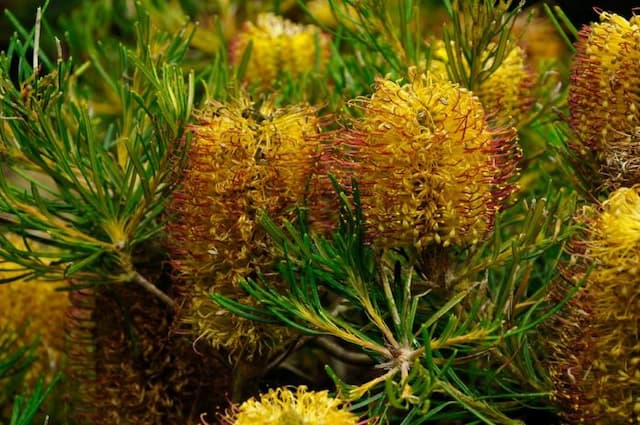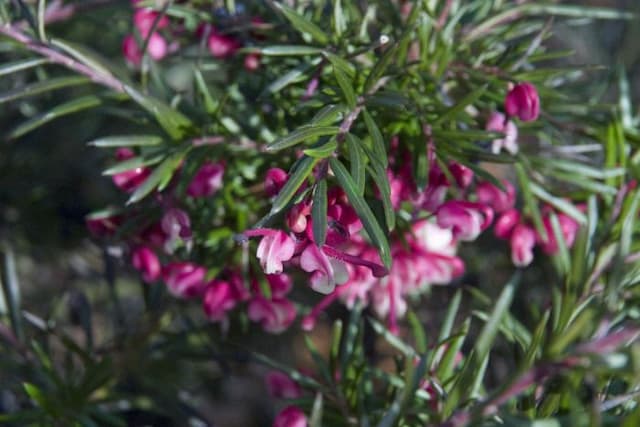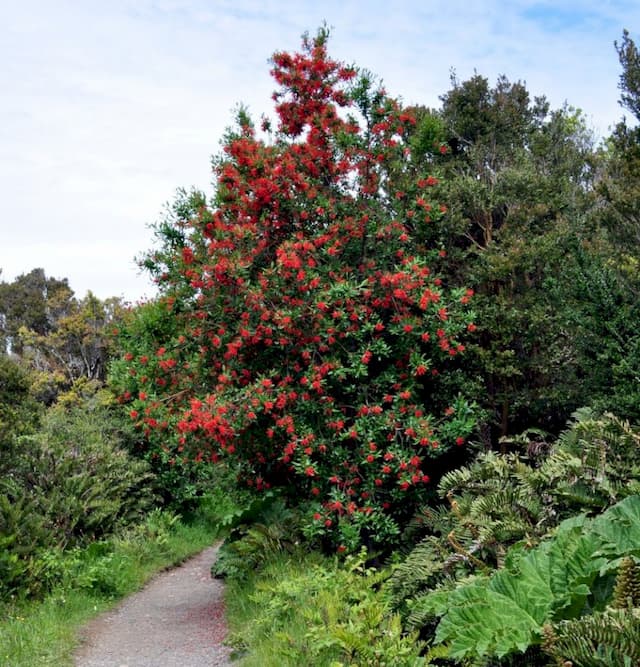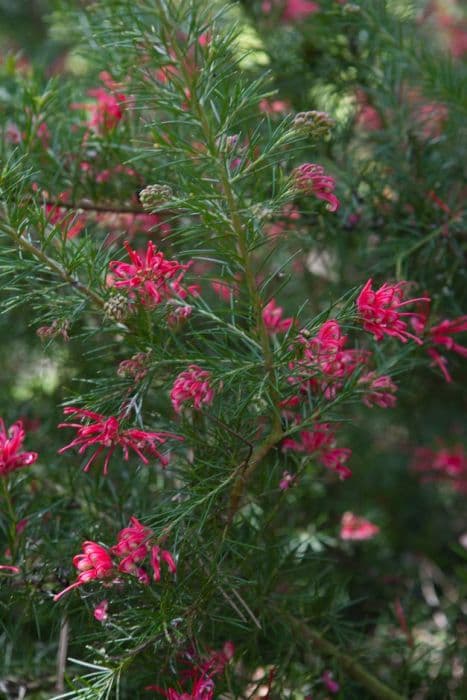Needle Bush Hakea Hakea lissosperma

ABOUT
Hakea lissosperma, commonly known as the Needle Bush due to its sharply pointed leaves, is a visually striking plant. The most prominent feature of the Needle Bush is its needle-like foliage, which is narrow, elongated, and sharply pointed at the tips, creating a dense and prickly appearance. These leaves emerge a soft gray-green, providing a unique texture to the foliage. The plant bears flowers that exhibit an intriguing arrangement, clustered together in rounded inflorescences. These blooms have a conspicuous and appealing look, typically displaying colors ranging from white to pink. The petals are diminutive but are often overshadowed by the prominent styles that jut out from the center of each flower, giving it a somewhat spidery appearance. Following the flowering phase, the Needle Bush produces fruits that are woody and robust, adding further interest to the plant's profile. These fruit capsules are shaped like a crescent or comma and will remain on the plant for a long time before opening to release seeds. The overall appeal of the Needle Bush is in its unique combination of needle-like foliage, showy flowers, and persistent, intriguing fruits which give it a distinctive presence in any landscape where it is grown. Its tough, spiky leaves also make it a great choice for gardeners seeking a plant with strong textural qualities.
About this plant
 Names
NamesFamily
Proteaceae
Synonyms
Needle Bush Hakea, Mountain Hakea
Common names
Hakea lissosperma.
 Toxicity
ToxicityTo humans
Hakea lissosperma, commonly known as the Needle Bush, does not have a well-documented profile with regards to human toxicity. There is limited information about its potential poisonous effects if ingested by humans. However, as with many plants, it is generally recommended to avoid ingesting parts of plants not known to be edible due to the risk of unknown toxic compounds. If a person were to ingest a part of the Needle Bush and experience symptoms such as nausea, vomiting, diarrhea, or allergic reactions, they should seek medical advice. It is important to consult local guidelines or a poison control center for more specific information about the toxicity of this plant.
To pets
Needle Bush is not commonly listed among plants that are known to be toxic to pets. However, the same precautions should be taken with pets as with humans since the full extent of Hakea lissosperma's toxicity is not well-documented. If a pet ingests part of this plant and shows signs of distress, illness, or an allergic reaction such as vomiting, drooling, or diarrhea, it is important to contact a veterinarian promptly. Pet owners should err on the side of caution and prevent their animals from ingesting plants that are not confirmed to be safe.
 Characteristics
CharacteristicsLife cycle
Perennials
Foliage type
Evergreen
Color of leaves
Green
Flower color
White
Height
10 feet (3 meters)
Spread
6 feet (1.8 meters)
Plant type
Shrub
Hardiness zones
9
Native area
Australia
Benefits
 General Benefits
General Benefits- Ecosystem Support: Hakea lissosperma, commonly known as Needle Bush, provides habitat and food for various wildlife species, including birds and insects.
- Ornamental Value: The Needle Bush boasts attractive flowers and foliage, making it a popular choice for ornamental gardens and landscaping projects.
- Drought Resistance: Adapted to withstand dry conditions, this plant can thrive in arid environments and requires minimal watering once established.
- Erosion Control: The robust root system of Hakea lissosperma helps to stabilize soil and prevent erosion on slopes and in erosion-prone areas.
- Windbreak: The dense growth habit of the Needle Bush can act as a windbreak, providing shelter for other plants and reducing wind erosion.
 Medical Properties
Medical PropertiesThis plant is not used for medical purposes.
 Air-purifying Qualities
Air-purifying QualitiesThis plant is not specifically known for air purifying qualities.
 Other Uses
Other Uses- Hakea lissosperma, commonly known as Needle Bush, can be used in floral arrangements for its unique and striking foliage and seed pods, providing texture and interest.
- The wood of Needle Bush might be used for crafting small wooden items such as handles or buttons, due to its firmness and fine grain.
- Landscape designers sometimes incorporate Needle Bush in gardens focusing on drought resistance because of its ability to thrive with low water inputs.
- The plant's resilience to coastal conditions makes it suitable for planting as a windbreak or hedge in seaside gardens.
- Needle Bush can serve as a habitat plant for native bird species, offering shelter and potential nesting sites within its dense foliage.
- The striking appearance of its flowers can be a source of inspiration for artists and photographers seeking natural beauty in their work.
- Needle Bush is used in educational settings such as botanical gardens to exemplify Australian flora and adaptive strategies to arid environments.
- The seeds of Needle Bush may be collected and used as a part of indigenous cultural practices or educational demonstrations about plant propagation.
- Needle Bush can play a role in soil stabilization projects in areas susceptible to erosion, thanks to its extensive root system.
- Entomologists might use the plant to study pollination biology, as its flowers attract a variety of nectar-feeding birds and insects.
Interesting Facts
 Feng Shui
Feng ShuiThe Needle Bush is not used in Feng Shui practice.
 Zodiac Sign Compitability
Zodiac Sign CompitabilityThe Needle Bush is not used in astrology practice.
 Plant Symbolism
Plant Symbolism- Resilience - Hakea lissosperma, commonly known as the Needlebush, often grows in tough, dry environments, symbolizing the ability to thrive despite challenging conditions.
- Protection - The sharp needles of the Needlebush serve as a natural deterrent to animals and can represent a protective barrier, symbolic of safeguarding one's personal space or beliefs.
- Adaptability - With its capacity to adapt to various soil types and climates, the Needlebush signifies flexibility and the capability to adjust to changing situations.
- Unique Beauty - The distinctive appearance of the Needlebush flowers and foliage suggests an appreciation for unique forms of beauty that defy conventional standards.
 Water
WaterThe Needle bush, commonly known as Hakea lissosperma, requires moderate watering. During its growing season in spring and summer, water the plant when the top inch of soil feels dry, which might be approximately once a week, using about 1 gallon of water each time for a medium-sized shrub. In the fall and winter, reduce watering to every other week or when the soil is dry to the touch, as the plant enters a dormant state and requires less water. Overwatering can lead to root rot, so it’s crucial to allow the soil to dry out between waterings.
 Light
LightFor the Needle bush, it is ideal to provide full sun to encourage healthy growth and flowering. It should be placed in a spot where it can receive at least six hours of direct sunlight daily. Partial shade is also tolerated, but the plant may not bloom as prolifically.
 Temperature
TemperatureThe Needle bush thrives in a temperature range between 50°F and 86°F. It can survive temperatures as low as 20°F but is not frost-tolerant, and extended exposure to temperatures below freezing can damage the plant. It is suited to USDA hardiness zones 9 through 11, where temperatures typically remain within this plant's preferred range.
 Pruning
PruningPruning a Needle bush, also known as Hakea lissosperma, is mainly for removing dead or diseased wood and shaping the plant. It's best to prune during late winter or early spring before new growth begins. Pruning can be done annually to maintain its desired size and shape, and to encourage healthy new growth.
 Cleaning
CleaningAs needed
 Soil
SoilNeedlebush prefers well-draining sandy or loamy soil with added organic matter. The soil pH should be slightly acidic to neutral, ranging from about 5.5 to 7.0. A mix containing equal parts of sand, loam, and compost or aged manure will create an ideal environment for these plants to thrive.
 Repotting
RepottingNeedlebush plants, being moderate growers, do not require frequent repotting. It is generally appropriate to repot these plants every two to three years or when they become root-bound. During repotting, it's essential to use fresh soil that matches the plant's natural preferences.
 Humidity & Misting
Humidity & MistingThe Needlebush prefers moderate to low humidity conditions typical of its native Australian environment. It is well-adapted to drier atmospheres and does not require high humidity levels to flourish.
 Suitable locations
Suitable locationsIndoor
Place in well-lit area & use sandy, well-draining soil.
Outdoor
Full sun or partial shade, well-draining soil, protect from frost.
Hardiness zone
9-11 USDA
 Life cycle
Life cycleHakea lissosperma, commonly known as the Needlebush Hakea, begins its life as a seed, which, when conditions are favorable, germinates and emerges as a seedling. The seedling grows into a juvenile plant, establishing a root system and a basic structure of leaves and stems. As it matures into an adult plant, the Needlebush Hakea develops woody stems and the characteristic needle-like leaves, while also producing flowers. The flowers are pollinated through the action of insects, birds, or wind, leading to the formation of woody fruit containing seeds. These fruits can persist on the plant for years until they are exposed to a trigger, such as fire, that causes them to open and release the seeds. The released seeds then lie dormant until conditions are right for the next generation of plants to begin the life cycle anew.
 Propogation
PropogationPropogation time
Spring
Hakea lissosperma, commonly known as Needle Bush, is typically propagated by seed. The ideal time for seed propagation is in spring after the last frost when temperatures start to warm. Seeds are extracted from the mature woody fruit that naturally splits open. Prior to sowing, it is beneficial to soak the seeds in water for around 24 hours to soften the seed coat. Sow the seeds in a well-draining seed-raising mix, placing them at a depth equal to their size, generally about 1/2 an inch (1.27 centimeters). Germination can be expected within 1 to 3 months if kept at about 70°F (21°C). Seedlings can then be potted on once they've grown large enough to handle and have developed a strong root system.









